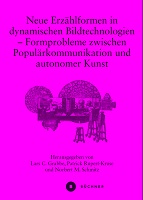Neue Erzählformen in dynamischen Bildtechnologien
Formprobleme zwischen Populärkommunikation und autonomer Kunst
Contributor(s)
Grabbe, Lars C. (editor)
Rupert-Kruse, Patrick (editor)
Schmitz, Norbert M. (editor)
Language
GermanAbstract
After a brief phase of playful experimentation, every advance, every major innovation in various media provokes renewed consolidation and aesthetic reflection: we have been familiar with this duality as a separation between mass communication and art since the days of industrial communication at the latest. This can also be observed in the development of the central perspective image, early photography and especially cinematography. After an initial phase of the cinema of attractions, a new and unique formal language of the Classical Style developed as a conventionalized design rule of film, which at the same time and sometimes in sharp opposition triggered various counter-movements or was reshaped as their explicit reflection by individual artistic formal languages. We are currently facing a similar situation, the invention and spread of three-dimensional dynamic techniques with data glasses and other technologies that enable new forms of virtual production and thus of storytelling - so-called 'spatial' or 'environmental storytelling'. This volume is dedicated to this new narrative on three levels: spatial image and sound (film), movement in space (computer games and VR) and space as context (AR). Jeder Fortschritt, jede Neuerung größeren Ausmaßes in verschiedenen Medien provoziert nach einer kurzen Phase spielerischen Experiments eine erneute Konsolidierung wie deren ästhetische Reflexion: Diese Dualität kennen wir spätestens seit den Tagen industrieller Kommunikation als eine Trennung zwischen Massenkommunikation und Kunst. Dies lässt sich gleichermaßen bei der Entwicklung des zentralperspektivischen Bildes, der frühen Fotografie oder ganz besonders der Kinematografie beobachten. Nach einer ersten Phase des Kinos der Attraktionen entwickelte sich eine neue und einzigartige Formensprache des Classical Style als konventionalisierte Gestaltungsregel des Films, die zugleich und teilweise in scharfer Opposition verschiedene Gegenbewegungen auslöste oder als deren explizite Reflexion durch individuelle künstlerische Formensprachen überformt wurde. Aktuell stehen wir vor einer ähnlichen Situation, der Erfindung und Verbreitung dreidimensionaler dynamischer Techniken mit Datenbrille und anderen Technologien, die neue Formen der Virtual Production und damit des Erzählens ermöglichen – sogenanntes ›spatial‹ oder ›environmental storytelling‹. Der Band widmet sich diesem neuen Erzählen auf drei Ebenen: Raumbild und -ton (Film), Bewegung im Raum (Computerspiel und VR) und Raum als Kontext (AR).
Keywords
media theory; image science; digital media; media technologies; virtual images; screen technologies; technological evolution; media studies; media art; narrative conventions; augmented reality; gaze; virtual realities; new narrative forms; moving image; storytelling; image narrativesDOI
10.14631/978-3-96317-944-0ISBN
9783963173806, 9783963179440Publisher
Büchner-VerlagPublication date and place
2024Series
Bewegtbilder, 9Classification
Media studies
Radio plays, scripts and performances


 Download
Download Web Shop
Web Shop